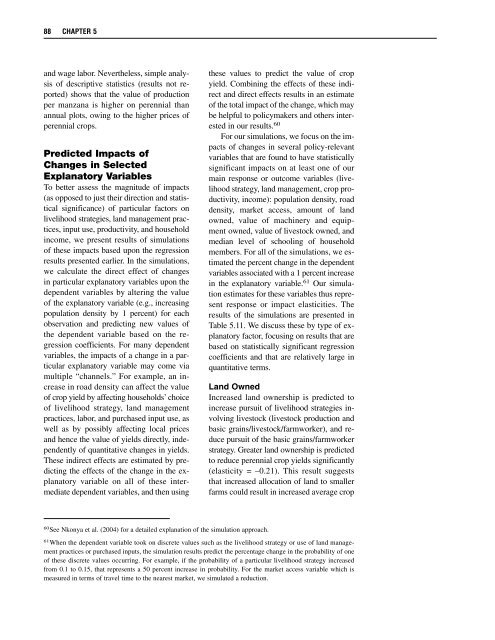Rural Development Policies and Sustainable Land Use in the ...
Rural Development Policies and Sustainable Land Use in the ...
Rural Development Policies and Sustainable Land Use in the ...
You also want an ePaper? Increase the reach of your titles
YUMPU automatically turns print PDFs into web optimized ePapers that Google loves.
88 CHAPTER 5<br />
<strong>and</strong> wage labor. Never<strong>the</strong>less, simple analysis<br />
of descriptive statistics (results not reported)<br />
shows that <strong>the</strong> value of production<br />
per manzana is higher on perennial than<br />
annual plots, ow<strong>in</strong>g to <strong>the</strong> higher prices of<br />
perennial crops.<br />
Predicted Impacts of<br />
Changes <strong>in</strong> Selected<br />
Explanatory Variables<br />
To better assess <strong>the</strong> magnitude of impacts<br />
(as opposed to just <strong>the</strong>ir direction <strong>and</strong> statistical<br />
significance) of particular factors on<br />
livelihood strategies, l<strong>and</strong> management practices,<br />
<strong>in</strong>put use, productivity, <strong>and</strong> household<br />
<strong>in</strong>come, we present results of simulations<br />
of <strong>the</strong>se impacts based upon <strong>the</strong> regression<br />
results presented earlier. In <strong>the</strong> simulations,<br />
we calculate <strong>the</strong> direct effect of changes<br />
<strong>in</strong> particular explanatory variables upon <strong>the</strong><br />
dependent variables by alter<strong>in</strong>g <strong>the</strong> value<br />
of <strong>the</strong> explanatory variable (e.g., <strong>in</strong>creas<strong>in</strong>g<br />
population density by 1 percent) for each<br />
observation <strong>and</strong> predict<strong>in</strong>g new values of<br />
<strong>the</strong> dependent variable based on <strong>the</strong> regression<br />
coefficients. For many dependent<br />
variables, <strong>the</strong> impacts of a change <strong>in</strong> a particular<br />
explanatory variable may come via<br />
multiple “channels.” For example, an <strong>in</strong>crease<br />
<strong>in</strong> road density can affect <strong>the</strong> value<br />
of crop yield by affect<strong>in</strong>g households’ choice<br />
of livelihood strategy, l<strong>and</strong> management<br />
practices, labor, <strong>and</strong> purchased <strong>in</strong>put use, as<br />
well as by possibly affect<strong>in</strong>g local prices<br />
<strong>and</strong> hence <strong>the</strong> value of yields directly, <strong>in</strong>dependently<br />
of quantitative changes <strong>in</strong> yields.<br />
These <strong>in</strong>direct effects are estimated by predict<strong>in</strong>g<br />
<strong>the</strong> effects of <strong>the</strong> change <strong>in</strong> <strong>the</strong> explanatory<br />
variable on all of <strong>the</strong>se <strong>in</strong>termediate<br />
dependent variables, <strong>and</strong> <strong>the</strong>n us<strong>in</strong>g<br />
<strong>the</strong>se values to predict <strong>the</strong> value of crop<br />
yield. Comb<strong>in</strong><strong>in</strong>g <strong>the</strong> effects of <strong>the</strong>se <strong>in</strong>direct<br />
<strong>and</strong> direct effects results <strong>in</strong> an estimate<br />
of <strong>the</strong> total impact of <strong>the</strong> change, which may<br />
be helpful to policymakers <strong>and</strong> o<strong>the</strong>rs <strong>in</strong>terested<br />
<strong>in</strong> our results. 60<br />
For our simulations, we focus on <strong>the</strong> impacts<br />
of changes <strong>in</strong> several policy-relevant<br />
variables that are found to have statistically<br />
significant impacts on at least one of our<br />
ma<strong>in</strong> response or outcome variables (livelihood<br />
strategy, l<strong>and</strong> management, crop productivity,<br />
<strong>in</strong>come): population density, road<br />
density, market access, amount of l<strong>and</strong><br />
owned, value of mach<strong>in</strong>ery <strong>and</strong> equipment<br />
owned, value of livestock owned, <strong>and</strong><br />
median level of school<strong>in</strong>g of household<br />
members. For all of <strong>the</strong> simulations, we estimated<br />
<strong>the</strong> percent change <strong>in</strong> <strong>the</strong> dependent<br />
variables associated with a 1 percent <strong>in</strong>crease<br />
<strong>in</strong> <strong>the</strong> explanatory variable. 61 Our simulation<br />
estimates for <strong>the</strong>se variables thus represent<br />
response or impact elasticities. The<br />
results of <strong>the</strong> simulations are presented <strong>in</strong><br />
Table 5.11. We discuss <strong>the</strong>se by type of explanatory<br />
factor, focus<strong>in</strong>g on results that are<br />
based on statistically significant regression<br />
coefficients <strong>and</strong> that are relatively large <strong>in</strong><br />
quantitative terms.<br />
L<strong>and</strong> Owned<br />
Increased l<strong>and</strong> ownership is predicted to<br />
<strong>in</strong>crease pursuit of livelihood strategies <strong>in</strong>volv<strong>in</strong>g<br />
livestock (livestock production <strong>and</strong><br />
basic gra<strong>in</strong>s/livestock/farmworker), <strong>and</strong> reduce<br />
pursuit of <strong>the</strong> basic gra<strong>in</strong>s/farmworker<br />
strategy. Greater l<strong>and</strong> ownership is predicted<br />
to reduce perennial crop yields significantly<br />
(elasticity = –0.21). This result suggests<br />
that <strong>in</strong>creased allocation of l<strong>and</strong> to smaller<br />
farms could result <strong>in</strong> <strong>in</strong>creased average crop<br />
60<br />
See Nkonya et al. (2004) for a detailed explanation of <strong>the</strong> simulation approach.<br />
61<br />
When <strong>the</strong> dependent variable took on discrete values such as <strong>the</strong> livelihood strategy or use of l<strong>and</strong> management<br />
practices or purchased <strong>in</strong>puts, <strong>the</strong> simulation results predict <strong>the</strong> percentage change <strong>in</strong> <strong>the</strong> probability of one<br />
of <strong>the</strong>se discrete values occurr<strong>in</strong>g. For example, if <strong>the</strong> probability of a particular livelihood strategy <strong>in</strong>creased<br />
from 0.1 to 0.15, that represents a 50 percent <strong>in</strong>crease <strong>in</strong> probability. For <strong>the</strong> market access variable which is<br />
measured <strong>in</strong> terms of travel time to <strong>the</strong> nearest market, we simulated a reduction.
















